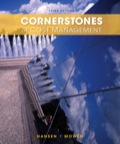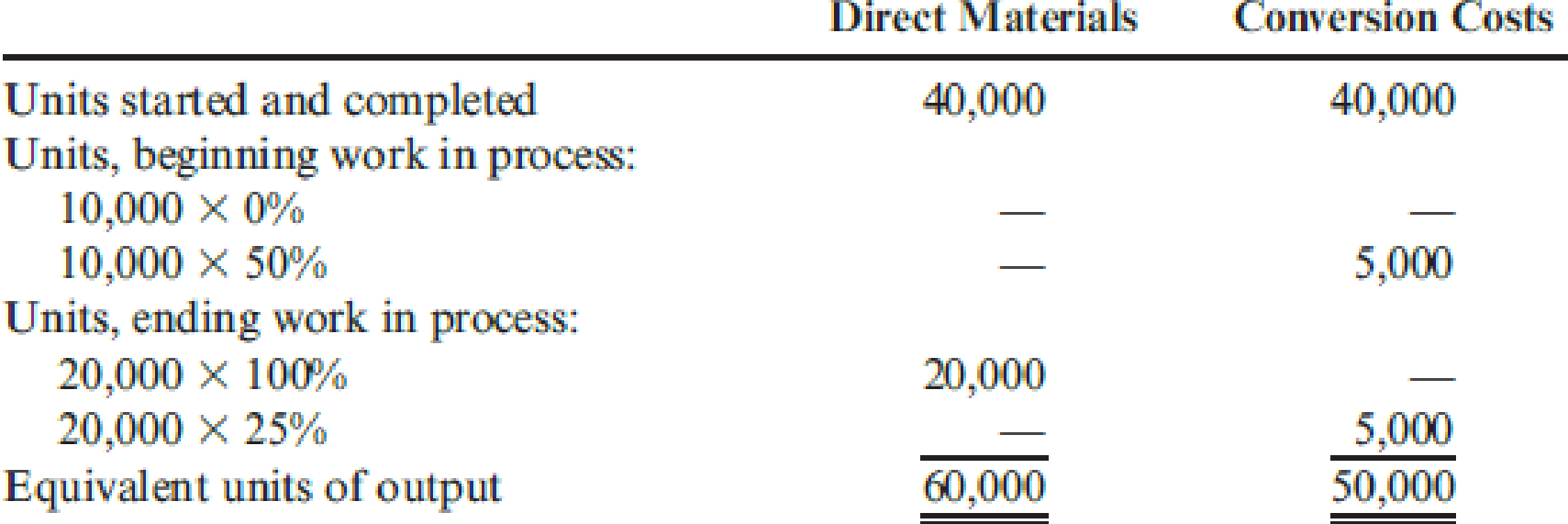
Concept explainers
Dama Company produces women’s blouses and uses the FIFO method to account for its

Costs in beginning work in process were direct materials, $20,000; conversion costs, $80,000. Manufacturing costs incurred during April were direct materials, $240,000; conversion costs, $320,000.
Required:
- 1. Prepare a physical flow schedule for April.
- 2. Compute the cost per equivalent unit for April.
- 3. Determine the cost of ending work in process and the cost of goods transferred out.
- 4. Prepare the
journal entry that transfers the costs from Cutting to Sewing.
1.
Prepare the schedule of physical flow.
Explanation of Solution
Process Costing: It is a method of cost accounting used by an enterprise with processes categorised by continuous production. The cost for manufacturing those products are assigned to the manufacturing department before the averaged over units are being produced.
Prepare the schedule of physical flow.
| Particulars | Units |
| Units to account for: | |
| Units, beginning work in process | 10,000 |
| Units started | 60,000 |
| Total units to account for | 70,000 |
| Units accounted for: | |
| Units started completed | 40,000 |
| Units, beginning work in process | 10,000 |
| Units, ending work in process | 20,000 |
| Total units accounted for | 70,000 |
(Table 1)
2.
Calculate the cost per equivalent unit for the month April.
Explanation of Solution
Calculate the cost per equivalent unit for the month April.
Working note 1: Calculate the unit material cost.
Working note 2: Calculate the unit conversion cost.
3.
Ascertain the value of cost of EWIP and the cost of goods transferred out.
Explanation of Solution
Ascertain the value of cost of EWIPs.
| Particulars | Amount in $ |
| Ending work in process: | |
| Direct materials (3) | 80,000 |
| Conversion cost (4) | 32,000 |
| Total cost of ending work in process | 112,000 |
(Table 2)
Ascertain the cost of goods transferred out.
| Particulars | Amount in $ |
| Cost of goods transferred out: | |
| Units started and completed (5) | 416,000 |
| Units, beginning work in process: | |
| Prior-period cost | 100,000 |
| Current costs to finish (6) | 32,000 |
| Total cost of goods transferred out | 548,000 |
(Table 3)
Working note 3: Calculate the units of direct materials during ending work in process.
Working note 4: Calculate the units of conversion cost during ending work in process.
Working note 5: Calculate the value of the units that were started and completed.
Working note 6: Calculate the current cost to finish.
4.
Journalize the given transaction.
Explanation of Solution
Journalize the given transaction.
| Date | Accounts title and explanation |
Debit ($) |
Credit ($) |
| Work in process (Sewing) | 548,000 | ||
| Work in process (Cutting) | 548,000 | ||
| (To record transfer of cost from cutting to sewing) |
(Table 4)
- Work in (sewing) is an asset and there is an increase in the value of an asset. Hence, debit the work in process account by $548,000.
- Work in process (cutting) is an asset and there is a decrease in the value of an asset. Hence, credit the work in process account by $548,000.
Want to see more full solutions like this?
Chapter 6 Solutions
EBK CORNERSTONES OF COST MANAGEMENT
- The formula to calculate the amount of manufacturing overhead to allocate to jobs is: Question content area bottom Part 1 A. predetermined overhead rate times the actual amount of the allocation base used by the specific job. B. predetermined overhead rate divided by the actual allocation base used by the specific job. C. predetermined overhead rate times the estimated amount of the allocation base used by the specific job. D. predetermined overhead rate times the actual manufacturing overhead used on the specific job.arrow_forwardThe Fantastic Ice Cream Shoppe sold 9,000 servings of ice cream during June for $4 per serving. The shop purchases the ice cream in large tubs from the Dream Ice Cream Company. Each tub costs the shop $9 and has enough ice cream to fill 20 ice cream cones. The shop purchases the ice cream cones for $0.10 each from a local warehouse club. Located in an outdoor mall, the rent for the shop space is $2,050 per month. The shop expenses $290 a month for the depreciation of the shop's furniture and equipment. During June, the shop incurred an additional $2,700 of other operating expenses (75% of these were fixed costs).arrow_forwardHello tutor please provide correct answer general accounting questionarrow_forward
- Robinson Manufacturing discovered the following information in its accounting records: $519,800 in direct materials used, $223,500 in direct labor, and $775,115 in manufacturing overhead. The Work in Process Inventory account had an opening balance of $72,400 and a closing balance of $87,600. Calculate the company’s Cost of Goods Manufactured.arrow_forwardSanjay would like to organize HOS (a business entity) as either an S corporation or as a corporation (taxed as a C corporation) generating a 16 percent annual before-tax return on a $350,000 investment. Sanjay’s marginal tax rate is 24 percent and the corporate tax rate is 21 percent. Sanjay’s marginal tax rate on individual capital gains and dividends is 15 percent. HOS will pay out its after-tax earnings every year to either its members or its shareholders. If HOS is taxed as an S corporation, the business income allocation would qualify for the deduction for qualified business income (assume no limitations on the deduction). Assume Sanjay does not owe any additional Medicare tax or net investment income tax. Required 1. For each scenario, C corporation and S corporation, calculate the total tax (entity level and owner level). 2. For each scenario, C corporation and S corporation, calculate the effective tax rate. C Corporation S Corporation 1. Total tax…arrow_forwardI need correct solution of this general accounting questionarrow_forward
- Hii expert please given correct answer general accountingarrow_forwardMarkowis Corp has collected the following data concerning its maintenance costs for the pest 6 months units produced Total cost July 18,015 36,036 august 37,032 40,048 September 36,036 55,055 October 22,022 38,038 November 40,040 74,575 December 38,038 62,062 Compute the variable coot per unit using the high-low method. (Round variable cost per mile to 2 decimal places e.g. 1.25) Compute the fixed cost elements using the high-low method.arrow_forwardUse the following data to determine the total dollar amount of assets to be classified as current assets. Marigold Corp. Balance Sheet December 31, 2025 Cash and cash equivalents Accounts receivable Inventory $67000 Accounts payable $126000 86500 Salaries and wages payable 11100 149000 Bonds payable 161500 Prepaid insurance 83000 Total liabilities 298600 Stock investments (long-term) 193000 Land 199500 Buildings $226000 Common stock 309400 Less: Accumulated depreciation (53500) 172500 Retained earnings 475500 Trademarks 133000 Total stockholders' equity 784900 Total assets $1083500 Total liabilities and stockholders' equity $1083500 ○ $269100 $385500 ○ $236500 ○ $578500arrow_forward
- Should the machine be replaced?arrow_forwardUsing the following balance sheet and income statement data, what is the total amount of working capital? Current assets $39700 Net income $52100 Current liabilities 19800 Stockholders' equity 96700 Average assets 198400 Total liabilities 52100 Total assets 148800 Average common shares outstanding was 18600. ○ $9900 ○ $39700 ○ $19900 ○ $12400arrow_forwardSuppose that Old Navy has assets of $4265000, common stock of $1018000, and retained earnings of $659000. What are the creditors' claims on their assets? ○ $2588000 ○ $3906000 ○ $1677000 ○ $4624000arrow_forward
 Cornerstones of Cost Management (Cornerstones Ser...AccountingISBN:9781305970663Author:Don R. Hansen, Maryanne M. MowenPublisher:Cengage Learning
Cornerstones of Cost Management (Cornerstones Ser...AccountingISBN:9781305970663Author:Don R. Hansen, Maryanne M. MowenPublisher:Cengage Learning Principles of Cost AccountingAccountingISBN:9781305087408Author:Edward J. Vanderbeck, Maria R. MitchellPublisher:Cengage LearningPrinciples of Accounting Volume 2AccountingISBN:9781947172609Author:OpenStaxPublisher:OpenStax College
Principles of Cost AccountingAccountingISBN:9781305087408Author:Edward J. Vanderbeck, Maria R. MitchellPublisher:Cengage LearningPrinciples of Accounting Volume 2AccountingISBN:9781947172609Author:OpenStaxPublisher:OpenStax College Managerial AccountingAccountingISBN:9781337912020Author:Carl Warren, Ph.d. Cma William B. TaylerPublisher:South-Western College Pub
Managerial AccountingAccountingISBN:9781337912020Author:Carl Warren, Ph.d. Cma William B. TaylerPublisher:South-Western College Pub Managerial Accounting: The Cornerstone of Busines...AccountingISBN:9781337115773Author:Maryanne M. Mowen, Don R. Hansen, Dan L. HeitgerPublisher:Cengage Learning
Managerial Accounting: The Cornerstone of Busines...AccountingISBN:9781337115773Author:Maryanne M. Mowen, Don R. Hansen, Dan L. HeitgerPublisher:Cengage Learning Financial And Managerial AccountingAccountingISBN:9781337902663Author:WARREN, Carl S.Publisher:Cengage Learning,
Financial And Managerial AccountingAccountingISBN:9781337902663Author:WARREN, Carl S.Publisher:Cengage Learning,





